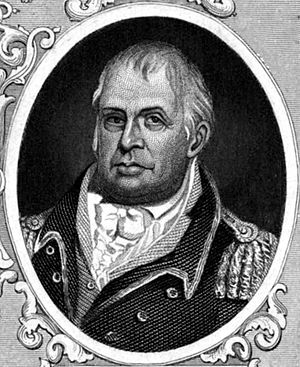William Heath facts for kids
Quick facts for kids
William Heath
|
|
|---|---|
 |
|
| Born | March 2, 1737 |
| Died | January 24, 1814 (aged 76) Roxbury, Massachusetts |
| Buried |
Forest Hills Cemetery
|
| Allegiance | |
| Service/branch | |
| Rank | Major General |
| Commands held | Ancient and Honorable Artillery Company of Massachusetts |
| Battles/wars | Battle of Lexington and Concord Siege of Boston Battle of Long Island Battle of Harlem Heights Battle of White Plains |
| Signature | |
William Heath (March 2, 1737 – January 24, 1814) was an important American leader. He was a farmer, a soldier, and a politician from Massachusetts. He became a major general in the Continental Army during the American Revolutionary War.
Contents
William Heath: A Revolutionary War General
Early Life and Military Start
William Heath lived his whole life on his family's farm. This farm was in Roxbury, Massachusetts. Today, this area is part of Jamaica Plain, Boston. His family had settled there way back in 1636.
Heath became very active in the local army, called the militia. By 1760, he was a captain of the Roxbury Company. This was a group within the Suffolk County militia. Ten years later, in 1770, he became the colonel and leader of the whole regiment.
He also joined the Ancient and Honorable Artillery Company of Massachusetts in 1765. He was elected as a lieutenant in 1768 and then as a captain in 1770.
Joining the Continental Army
In December 1774, the government in Massachusetts that supported the revolution made him a brigadier general. He led Massachusetts soldiers during the final part of the Battle of Lexington and Concord in April 1775. This was one of the first battles of the Revolutionary War.
After this battle, the siege of Boston began. Heath worked hard to train the militia troops involved in this siege. In June 1775, Massachusetts made him a major general in their state army. Soon after, the Continental Congress made him a brigadier general in the new Continental Army.
Defending New York City
In 1776, Heath helped defend New York City from the British. He was one of the people who told General Washington not to give up the city. He fought in several battles around New York. These included the Battle of Long Island, Harlem Heights, and White Plains.
In August 1776, he was promoted to major general in the Continental Army. However, General Washington had some doubts about Heath's skills. So, Washington often placed him in areas where no major fighting was expected.
Later War Roles
In November 1776, Heath was put in charge of troops in the Hudson River Highlands. In January 1777, Washington asked Heath to attack Fort Independence in New York. This attack was meant to help Washington's actions at Trenton and Princeton. But Heath's attack did not go well, and his troops were defeated.
General Washington criticized Heath for this. After that, Heath was never given command of troops in actual combat again. He was later put in charge of the Convention Army. These were the British troops led by John Burgoyne who surrendered after the Battle of Saratoga. In 1780, he returned to command the Highland Department. This happened after Benedict Arnold betrayed the American cause.
In 1783, he became an original member of The Society of the Cincinnati in Massachusetts. This was a group for officers who served in the Continental Army.
After the War
After the war ended, William Heath continued to serve his country. He was a member of the Massachusetts Convention in 1788. This group voted to approve the United States Constitution.
He also served in the Massachusetts Senate from 1791 to 1792. Later, he became a judge in a probate court. In 1806, he was chosen to be the Lieutenant Governor of Massachusetts. However, he decided not to take the job.
William Heath passed away at his home in Roxbury on January 24, 1814. He was buried nearby in Forest Hills Cemetery. The town of Heath, Massachusetts, was named in his honor.
Images for kids
See also
 In Spanish: William Heath para niños
In Spanish: William Heath para niños

